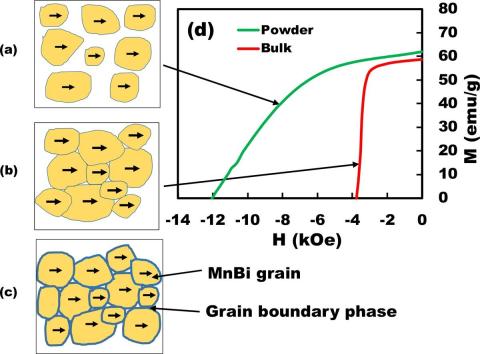Researchers from the Department of Energy’s Critical Materials Institute (CMI) and Ames National Laboratory have improved the properties of a rare-earth-free permanent magnet material and demonstrated the process can be upscaled for manufacturing. The researchers developed a new method of manufacturing manganese bismuth (MnBi) magnets based on microstructure engineering. This process is a step towards making compact, energy-efficient motors without the use of rare earths.
High-power permanent magnets are increasingly important for a variety of renewable energy technologies, including wind turbines and electric cars. According to Wei Tang, CMI researcher and Ames Lab scientist, these magnets are currently constructed from rare earth elements such as neodymium and dysprosium. However, he explained that these elements are low-stock and high-demand, leading to an unreliable supply chain and high prices. One solution to this problem is for scientists to find alternative materials, such as the MnBi used in this research.
Permanent magnets used for motors require high energy density, or high levels of magnetism and coercivity. Coercivity is a magnet’s ability to maintain its current level of magnetism, despite exposure to high heat and outside influences that could demagnetize it.
“If we use high power density magnets, we can reduce the motor size and make a more compact motor,” said Tang. “Right now it is very important that we can make some devices smaller and more compact, more energy-efficient.”
The challenge with MnBi is that traditional manufacturing methods require high heat to transform the individual materials into a large magnet. The necessary heat reduces the energy density of the magnet. To address this problem, the team developed an alternative process.

Tang said that they started with a very fine powder for each of the materials, which increases the starting magnetic energy level. Next, they used a warm heating method rather than a high-temperature method for forming the magnet. Finally, the key to their new process was to add a non-magnetic component that would keep the grain particles from touching each other. This additional element, called a grain boundary phase, provides more structure to the magnet, and keeps the magnetism running through individual particles/grains from affecting one another.
“It is like the structural material,” Tang said. “It’s like if we use concrete to build a wall. With just the concrete itself, it’s weak, but if we put a steel rebar inside first then pour the concrete, it’s going to several dozen times stronger.”
The effect of the warm temperature on the magnetic properties of MnBi is unique. The researchers expected the coercivity and magnetism to decrease with increasing temperature, which is true for most magnetic materials. However, for MnBi, the warm temperature increased the coercivity and decreased the magnetization. This increased coercivity helps to keep the magnet more stable at elevated temperatures than other known magnets.

The team also focused on making larger magnets, compared to the typically small magnets developed in labs. Upsizing the magnets helps to demonstrate to the manufacturing companies that they can build large magnets on a commercial scale.
“If we cannot make the larger one, we cannot use it for any application,” Tang said. “We need a big magnet, and we need to make it into whatever the shape needed. Also, we need to be able to mass produce at a low cost. This is important for future applications.”
The team is currently working with PowderMet Inc., using their patent pending techniques to pursue mass production of the MnBi magnets for use in novel electric motors. That project is funded by the DOE Small Business Innovation Research program. The project has already entered phase II, which means that the project has been proven feasible and additional funding has been awarded to further develop and demonstrate the technology.
This research is further discussed in the paper “Engineering microstructure to improve coercivity of bulk MnBi magnet,” written by Wei Tang, Gaoyuan Ouyang, Xubo Liu, Jing Wang, Baozhi Cui, and Jun Cui, and published in the Journal of Magnetism and Magnetic Materials.
The Critical Materials Institute is a Department of Energy Innovation Hub led by the U.S. Department of Energy's Ames National Laboratory and supported by the Office of Energy Efficiency and Renewable Energy’s Advanced Manufacturing Office, working to decarbonize industry and increase the competitiveness of the U.S. manufacturing and clean energy sectors through process innovations, collaborations, research and development, and technical assistance and workforce training. The CMI seeks ways to eliminate and reduce reliance on rare-earth metals and other materials critical to the success of clean energy technologies.
Ames National Laboratory is a U.S. Department of Energy Office of Science National Laboratory operated by Iowa State University. Ames Laboratory creates innovative materials, technologies, and energy solutions. We use our expertise, unique capabilities, and interdisciplinary collaborations to solve global problems.
Ames National Laboratory is supported by the Office of Science of the U.S. Department of Energy. The Office of Science is the single largest supporter of basic research in the physical sciences in the United States and is working to address some of the most pressing challenges of our time. For more information, please visit https://energy.gov/science.
